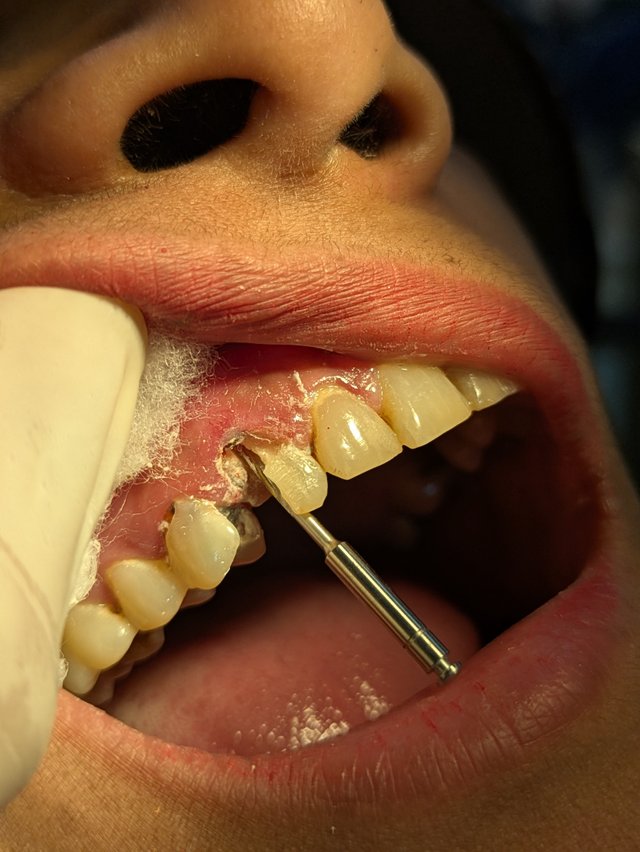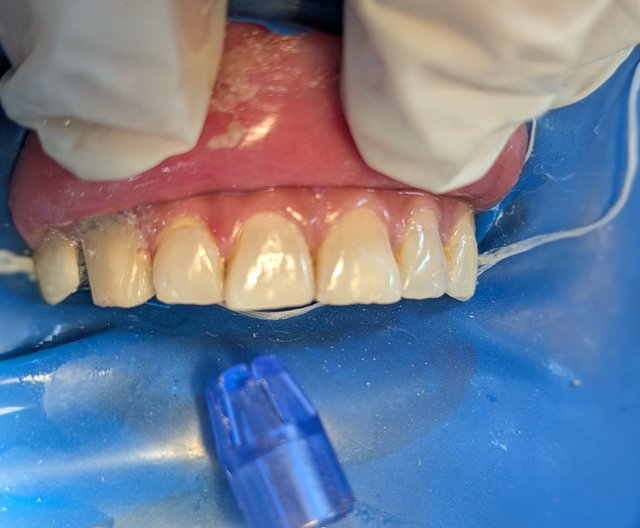Sensitive Content: Restoring a tooth with Post and Core

With Season 21 of the Engagement Challenge finally over, I now have some time to post personal blogs of my own. To be honest, preparing lessons and grading assignments took up most of my time on Steemit.
During this period, my personal and professional life continued to follow the same routine, with my mornings dedicated to working as a dentist at the hospital. Amidst this daily routine, I encountered a specific case that I documented and thought of sharing here on my profile.
Recently, I performed a root canal treatment on a patient. Since the patient had almost no tooth structure left, I had to opt for a post and core treatment. What is post and core? Let’s find out:
Post and core build-up is a restorative procedure that strengthens a tooth after significant structural loss, often following endodontic treatment. The process combines a post inserted into the root canal and a core build-up to restore the tooth's shape and function.
When a tooth undergoes a root canal, its internal nerve and blood supply are removed, often leaving the tooth weak and brittle. This process acts like rebuilding the foundation and structure of a damaged house.
The first step obviously was to perform the Root Canal treatment.
A root canal treatment is a dental procedure designed to save a tooth that is severely decayed or infected. Inside every tooth, there’s a soft tissue called the pulp, which contains nerves and blood vessels. When this pulp becomes infected due to deep cavities, cracks, or trauma, it can cause severe pain and swelling.
During the treatment, the dentist removes the infected pulp, cleans the inside of the tooth, and disinfects the root canals to eliminate bacteria. The empty canals are then filled with a rubber-like material called Gutta Percha to seal them and prevent reinfection. Finally, the tooth is restored with a filling or crown to bring it back to its original shape and strength.
In simple terms, a root canal is like deep cleaning for a tooth’s roots, saving it from extraction and allowing you to chew and smile without discomfort.

After completing the root canal treatment, considering the compromised condition of the tooth structure, it was decided to proceed with a post and core restoration. Among the various types of posts available, a fiber post was chosen due to its favorable properties such as biocompatibility, aesthetics, and reduced risk of root fracture. To insert the fiber post into the tooth socket, it is essential to drill out a portion of the gutta-percha (GP) from the root canal. However, care must be taken to leave at least 4-5 mm of GP at the apical end to preserve the seal and prevent leakage. Additionally, the fiber post should be inserted to a length of at least one-third of the root canal to ensure adequate retention and stability. This step is crucial for the long-term success of the post and core restoration.

After the preparation of the tooth socket was completed, the fiber post was carefully inserted into the canal. Special attention was given to ensure that there was no gap or space between the post and the canal walls, thereby maintaining a tight seal. This meticulous placement is critical to prevent any future bacterial contamination, which could compromise the success of the treatment. Once the post was properly positioned and securely seated within the prepared socket, it was sealed using flowable composite. The use of flowable composite allowed for optimal adaptation around the post, further ensuring a strong and durable bond.
Since composite materials require light curing to harden, a UV curing light was used to fully set the composite and secure the post firmly in place. Proper curing is essential to achieve the desired strength and stability of the restoration. By following this protocol, the foundation for a reliable and long-lasting restoration was successfully established.

After that, the final step was to restore the tooth using composite, utilizing the fiber post as a support structure. This is why the procedure is referred to as "post and core." The fiber post serves as the core around which the restoration is built, providing strength and stability to the tooth. Although the process was intricate and required precision, I managed to complete it successfully. The results were satisfying and demonstrated the effectiveness of the technique.

I hope this was an interesting read to you all. If you have any questions do let me know in the comments section.
Regards,
Dr Huzaifa Naveed
@tipu curate
Upvoted 👌 (Mana: 2/7) Get profit votes with @tipU :)